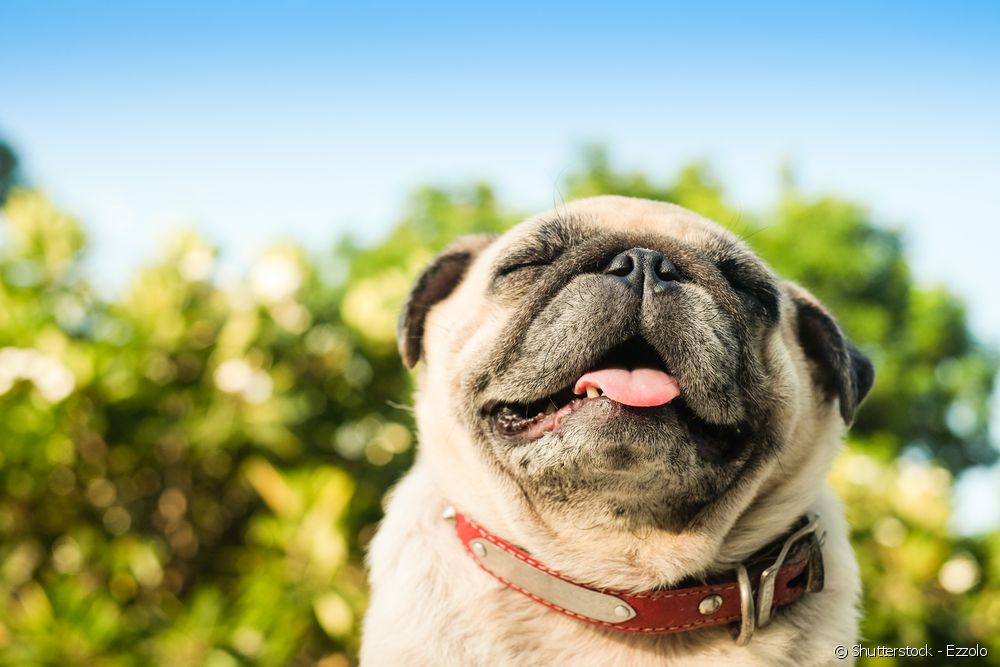Why do some dog breeds have a flattened muzzle?

Table of contents
When talking about "flat-nosed dog", many people are actually referring to some kind of Bulldog, the Pug or the Shih Tzu. But the truth is that there are also large brachycephalic breeds, such as the Cane Corso. Flat-nosed is not an exclusivity of small breeds! Therefore, we will explain the reasons why some dog breeds have a flattened muzzle, which ones?care is needed to maintain the health of these animals and what kind of health problems these puppies tend to develop. keep reading!
Dogs with flattened muzzles can also be called brachycephalic dogs.
Short snout, compressed skull and reduced upper respiratory system: these are the main characteristics of brachycephalic dogs. This anatomy is the result of a series of crossbreeding, made with the aim of compacting the upper jaws of these animals. The friendly face of flat-nosed dogs gives away some of the cheerful personality of these pets. But the reasons behind it areIn the case of the English Bulldog, for example, the flat face was very useful for attacking bulls, in a very controversial and violent sport, Bull-baiting. With time and coexistence with humans, the personality of this breed of dog became more affable, but some physical characteristics remained.

Dog: flattened muzzle requires special care
Less space in the mouth for the organization of the dental arch is a common feature in flat-nosed dogs. Therefore, it is super important to take care of the oral hygiene of these little furry ones, brushing their teeth daily. Some brachycephalic dogs also need to have their diet controlled and exercise regularly, to avoid a picture of obesity that would make the condition even worse.In the case of dogs with flattened snouts and folds on the face, it is essential to clean the inside of the skin folds with a damp cloth, as well as drying the area to prevent the proliferation of fungi.
Health problems that flat nose dog may have to face
Stenosis of the nostrils: narrowing of the nostrils, which can also affect the pharynx, is very common in brachycephalic dogs and may require surgical intervention to correct breathing;
Elongated soft palate: this part of the canine anatomy is located inside the throat, in the continuation of the roof of the dog's mouth (the hard palate). The extension of the soft palate causes vibrations when the dog breathes, as if it were a kind of snoring;
Overheating: Dogs control their body temperature through breathing, so if they can't breathe comfortably, they are more prone to overheating, especially on hot days.
Dry eyes: the compact skull of brachycephalic dogs also makes their eyes more exposed, so that the eyelids cannot completely enclose them. The consequence of this is chronic dryness in the eyes, as well as a high possibility of the eyes popping out of the socket when minor accidents occur with the dog.
See_also: See the list of protein-rich dog foods (with infographic)Dog without a muzzle: meet the breeds
The most famous brachycephalic dogs are undoubtedly the English Bulldog, the French Bulldog and the Pug. But there is a list of dog breeds with flat faces and different characteristics: large, medium or small size, calmer or more playful temperament and with different coat styles. See some examples:
Affenpinscher
American Cocker Spaniel
Boston Terrier
Boxer
Bullmastiff
Cane Corso
Cavalier King Charles Spaniel
Chihuahua
Chow Chow
See_also: Large hairy dog breed: how to care for their coat at home?Dogue de Bordeaux
Lhasa Apso
Pekingese
Shar-Pei
Shih Tzu

